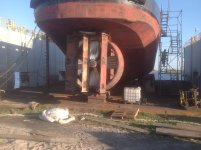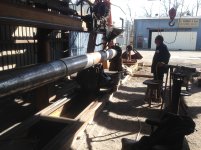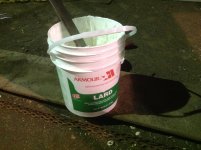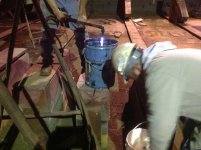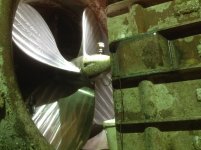Worked for the local school district Journey level carpenter at the maintenance Dept. and have been exposed to high levels short duration numerious times and it too concerns me. Worked my up to department head carpentry dept. with 11 men under me. I took a class and got my Asbestos Inspector, Manager, Planner Certs.and would not let my guys touch it there after. Best thing I ever did as it now made me just as responsible as the district. When those above would say just do it and don't worry about having it abated as they once did me. I could now just simply say I can't as I could now get sued personally and loose all that own and all though it pissed them off to have to now spend the abatement money it was also the best protection my guys now had. For those that might not know it could be found in the floors, walls, ceilings both plaster or drop in tiles, doors, roofs adhesives just about everything we worked on or had to patch of replace. I could now even protect the students and staff as well being just as important to me. We maintained 42 sites so it was not a small problem. Unfortunately the other department heads, plumbing, electrical, HVAC etc.including my immediate supervisor purposely flunked the class and could then continue to ignore it's health risks to all including the students, staff and their own workers. Newer schools should be Asbestos free by law but it does not always hold true unless certified to be so. Those who have children still in school can go to any school site and request to look at their AHERA Asbestos management plan. It will list all the areas still containing asbestos and must be updated yearly.
You are using an out of date browser. It may not display this or other websites correctly.
You should upgrade or use an alternative browser.
You should upgrade or use an alternative browser.
Shipyard stories
- Thread starter dmort
- Start date
A way to get around them to try and look good for all the shirts and ties down town by saving money yet risking and not caring about anyones personal health not even the students no matter how young. I refused to play that game and eventually it became a personal hardship with no regrets.
JLouis
JLouis
dmort
Active member
Scraping
I learned to scrape in early 1965 while working at a naval shipyard.
My very first assignment was to a turbine section on the day shift. There I met a tall lanky guy from the Southeast with an obvious accent. He asked me if I ever scraped before....I said no. He said I hope you learn to like it because you will be doing a lot of it here.
The turbine case halves had a fairly wide flange surface with no seals. These were WWII design turbines and they operated with up to 800 pound of steam pressure. Later designs would produce upwards of 1200 pounds.
The flange surface was all hand scraped using Prussian Blue. The large flat plate was raised and lowered with an electric hoist.
The scrapers were made from aluminum tubing, flattened in a vise on one end, with the other end covered with a rubber cup that would fit on the legs of your patio furniture. The tool room would affix the carbide tip to your tubing and off you go. I ended up with two, one maybe 5 inches longer than the other. That was all about how far I was leaning over the work piece while scraping. The pressure you put on the scraper makes a difference and it also depends how tired you are.
My mentor was the one who would make those little sails or half crescents. I think when he was at the end of a stroke and lifting, there would be a little more pressure with his left hand. It happened so quick it wasn't easy to see.
Sometimes I would get a break from scraping to make taper pins for turbine cases that had been fit together and aligned. The case flanges were pretty thick and had existing tapered holes. They usually had to be reamed and new pins made.
You would cut tapered stock to length and using a collect, turn and thread the large end, making sure the shoulder below the threads was below the flange surface. You would then tap the pin in with brass stock and thread on a nut to protect the threads and make easy to remove down the road. I liked scraping and when you like what you are doing you usually become pretty good at it. When a shop finds out what you are good at, those jobs will come your way. I scraped new pads for mounting machinery aboard ship when I was working nights...not the kind of work for old guys 'cause you are often working on your knees.
Scraping can be attractive as well as functional. Anyone down the line that saw my mentors scraping on a turbine case, would only have one thing to say...Wow!!
Mort
I learned to scrape in early 1965 while working at a naval shipyard.
My very first assignment was to a turbine section on the day shift. There I met a tall lanky guy from the Southeast with an obvious accent. He asked me if I ever scraped before....I said no. He said I hope you learn to like it because you will be doing a lot of it here.
The turbine case halves had a fairly wide flange surface with no seals. These were WWII design turbines and they operated with up to 800 pound of steam pressure. Later designs would produce upwards of 1200 pounds.
The flange surface was all hand scraped using Prussian Blue. The large flat plate was raised and lowered with an electric hoist.
The scrapers were made from aluminum tubing, flattened in a vise on one end, with the other end covered with a rubber cup that would fit on the legs of your patio furniture. The tool room would affix the carbide tip to your tubing and off you go. I ended up with two, one maybe 5 inches longer than the other. That was all about how far I was leaning over the work piece while scraping. The pressure you put on the scraper makes a difference and it also depends how tired you are.
My mentor was the one who would make those little sails or half crescents. I think when he was at the end of a stroke and lifting, there would be a little more pressure with his left hand. It happened so quick it wasn't easy to see.
Sometimes I would get a break from scraping to make taper pins for turbine cases that had been fit together and aligned. The case flanges were pretty thick and had existing tapered holes. They usually had to be reamed and new pins made.
You would cut tapered stock to length and using a collect, turn and thread the large end, making sure the shoulder below the threads was below the flange surface. You would then tap the pin in with brass stock and thread on a nut to protect the threads and make easy to remove down the road. I liked scraping and when you like what you are doing you usually become pretty good at it. When a shop finds out what you are good at, those jobs will come your way. I scraped new pads for mounting machinery aboard ship when I was working nights...not the kind of work for old guys 'cause you are often working on your knees.
Scraping can be attractive as well as functional. Anyone down the line that saw my mentors scraping on a turbine case, would only have one thing to say...Wow!!
Mort
Last edited:
jackie schmidt
New member
I learned to scrape in early 1965 while working at a naval shipyard.
My very first assignment was to a turbine section on the day shift. There I met a tall lanky guy from the Southeast with an obvious accent. He asked me if I ever scraped before....I said no. He said I hope you learn to like it because you will be doing a lot of it here.
The turbine case halves had a fairly wide flange surface with no seals. These were WWII design turbines and they operated with up to 800 pound of steam pressure. Later designs would produce upwards of 1200 pounds.
The flange surface was all hand scraped using Prussian Blue. The large flat plate was raised and lowered with an electric hoist.
The scrapers were made from aluminum tubing, flattened in a vise on one end, with the other end covered with a rubber cup that would fit on the legs of your patio furniture. The tool room would affix the carbide tip to your tubing and off you go. I ended up with two, one maybe 5 inches longer than the other. That was all about how far I was leaning over the work piece while scraping. The pressure you put on the scraper makes a difference and it also depends how tired you are.
My mentor was the one who would make those little sails or half crescents. I think when he was at the end of a stroke and lifting, there would be a little more pressure with his left hand. It happened so quick it wasn't easy to see.
Sometimes I would get a break from scraping to make taper pins for turbine cases that had been fit together and aligned. The case flanges were pretty thick and had existing tapered holes. They usually had to be reamed and new pins made.
You would cut tapered stock to length and using a collect, turn and thread the large end, making sure the shoulder below the threads was below the flange surface. You would then tap the pin in with brass stock and thread on a nut to protect the threads and make easy to remove down the road. I liked scraping and when you like what you are doing you usually become pretty good at it. When a shop finds out what you are good at, those jobs will come your way. I scraped new pads for mounting machinery aboard ship when I was working nights...not the kind of work for old guys 'cause you are often working on your knees.
Scraping can be attractive as well as functional. Anyone down the line that saw my mentors scraping on a turbine case, would only have one thing to say...Wow!!
Mort
In the '80's, we had a contract to build the prop shafts and line shafts for several 20,000 HP notch tugs. The line shafts were 18 inch diameter, and set in two white metal bearings. The final job before the final great alignment was scraping these Babbitt Bearings in. It involved coating the shaft journal with Prussian "Red", lowering it into the Bearings, turning it Bout 1/8 turn, lifting it out, and scraping the high spots.
This was tedious and time consuming work.
Mort, if you recall, I posted a picture of a large 12 ft diameter prop we were fitting in our Shop on a shaft we rebuilt. Here it is installed in the Harbor Tug.
http://benchrest.com/attachment.php?attachmentid=20412&stc=1&d=1512268623
Attachments
dmort
Active member
Babbitt Bearings
Jackie,
An 18" diameter shaft. That's a large. How long were they?
We had an enclosed Babbitt room at the North end of our shop. They poured the Babbitt bearings for the steam turbines and what ever else came along.
I don't remember the shaft diameter we were working with, but I will guess and say 8 inches? Anyway, the amount of hand scraping was minor in comparison.
The Babbitt room was a lot warmer than rest of our large open shop area. In the Babbitt room were individual compartments/boxes for storing welding rod.
I was told it was important to keep it warm...I don't remember why. The guys welding on a dead ship or a carrier deck at night did't have warm welding rod.
The thing I do remember about the rod boxes in the Babbitt room is pretty basic...as it concerns food. If there was something in your lunch pail that would taste better warm...put it in the rod box right after clocking in.
Mort
P.S. Thanks for the pic
Jackie,
An 18" diameter shaft. That's a large. How long were they?
We had an enclosed Babbitt room at the North end of our shop. They poured the Babbitt bearings for the steam turbines and what ever else came along.
I don't remember the shaft diameter we were working with, but I will guess and say 8 inches? Anyway, the amount of hand scraping was minor in comparison.
The Babbitt room was a lot warmer than rest of our large open shop area. In the Babbitt room were individual compartments/boxes for storing welding rod.
I was told it was important to keep it warm...I don't remember why. The guys welding on a dead ship or a carrier deck at night did't have warm welding rod.
The thing I do remember about the rod boxes in the Babbitt room is pretty basic...as it concerns food. If there was something in your lunch pail that would taste better warm...put it in the rod box right after clocking in.
Mort
P.S. Thanks for the pic
Last edited:
QUOTE=dmort;802983]Jackie,
The Babbitt room was a lot warmer than rest of our large open shop area. In the Babbitt room were individual compartments/boxes for storing welding rod.
I was told it was important to keep it warm...I don't remember why. The guys welding on a dead ship or a carrier deck at night did't have warm welding rod.
The thing I do remember about the rod boxes in the Babbitt room is pretty basic...as it concerns food. If there was something in your lunch pail that would taste better warm...put it in the rod box right after clocking in.
[/QUOTE]
Welding rod would be stored in a rod oven. To keep it dry. Late 80's started to see rod marked with an "M". But, they still kept it in a rod oven.....
The shipyard I worked at 86-93'. You got fired, if there was food in the rod oven.
The Babbitt room was a lot warmer than rest of our large open shop area. In the Babbitt room were individual compartments/boxes for storing welding rod.
I was told it was important to keep it warm...I don't remember why. The guys welding on a dead ship or a carrier deck at night did't have warm welding rod.
The thing I do remember about the rod boxes in the Babbitt room is pretty basic...as it concerns food. If there was something in your lunch pail that would taste better warm...put it in the rod box right after clocking in.
[/QUOTE]
Welding rod would be stored in a rod oven. To keep it dry. Late 80's started to see rod marked with an "M". But, they still kept it in a rod oven.....
The shipyard I worked at 86-93'. You got fired, if there was food in the rod oven.
dmort
Active member
Hot Food And Rod Ovens
Tim,
Thanks for the info.
I'm sure the Navy had a policy somewhere about heating food in a rod oven.
One of the perks about working nights in the machine shop,is we pretty much had the place to ourselves....Warm food and easy parking.
I apologize for calling you Mike in my prior post.....I do appreciate your input.
Mort
Tim,
Thanks for the info.
I'm sure the Navy had a policy somewhere about heating food in a rod oven.
One of the perks about working nights in the machine shop,is we pretty much had the place to ourselves....Warm food and easy parking.
I apologize for calling you Mike in my prior post.....I do appreciate your input.
Mort
Last edited:
QUOTE=dmort;802983]Jackie,
The Babbitt room was a lot warmer than rest of our large open shop area. In the Babbitt room were individual compartments/boxes for storing welding rod.
I was told it was important to keep it warm...I don't remember why. The guys welding on a dead ship or a carrier deck at night did't have warm welding rod.
The thing I do remember about the rod boxes in the Babbitt room is pretty basic...as it concerns food. If there was something in your lunch pail that would taste better warm...put it in the rod box right after clocking in.
Welding rod would be stored in a rod oven. To keep it dry. Late 80's started to see rod marked with an "M". But, they still kept it in a rod oven.....
The shipyard I worked at 86-93'. You got fired, if there was food in the rod oven.[/QUOTE]
Rod is kept warm to limit humidity in the flux cores and exterior coatings.
It is dry that is more important than just warm.
The short time out of storage before use is not going to cause much of a problem.
dmort
Active member
The work place
When I was a little kid, one of the things you would be graded on was "works and plays well with others".... or something like that. It is just as, or more important, in the work place than it was in kindergarten.
I got a taste of working nights on projects that the Navy thought required a double shift. When those jobs were done you were back on day shift. Compared to working nights day shift was a circus....noise and people everywhere. No place to park and no warm sandwiches.
The first time I turned off my machine at lunch on the night shift, I was invited to the day shift foreman's office for lunch.
These guys had a reputation for taking any machine job that came in, as opposed to working in a particular section. As an example my day shift section was floor and large horizontal milling machines. I could have stayed there the rest of my short career with the Navy, and never got my Journeyman papers. I had been working as a limited machinist/machine operator which of course paid less.
Everyone on the night shift were experienced journeyman so my shift change was conditional. An important part of it had to do with the approval the day shift grinding room foreman.
An even more important part of it was the acceptance by my peers of a twenty something year old who still had a lot to learn.
Being accepted by these guys who were always willing to help me make a difference. I got my journeyman papers in less than 3 years.
Sometimes how well you get along in the work place can be more important than your skill level.
Mort
When I was a little kid, one of the things you would be graded on was "works and plays well with others".... or something like that. It is just as, or more important, in the work place than it was in kindergarten.
I got a taste of working nights on projects that the Navy thought required a double shift. When those jobs were done you were back on day shift. Compared to working nights day shift was a circus....noise and people everywhere. No place to park and no warm sandwiches.
The first time I turned off my machine at lunch on the night shift, I was invited to the day shift foreman's office for lunch.
These guys had a reputation for taking any machine job that came in, as opposed to working in a particular section. As an example my day shift section was floor and large horizontal milling machines. I could have stayed there the rest of my short career with the Navy, and never got my Journeyman papers. I had been working as a limited machinist/machine operator which of course paid less.
Everyone on the night shift were experienced journeyman so my shift change was conditional. An important part of it had to do with the approval the day shift grinding room foreman.
An even more important part of it was the acceptance by my peers of a twenty something year old who still had a lot to learn.
Being accepted by these guys who were always willing to help me make a difference. I got my journeyman papers in less than 3 years.
Sometimes how well you get along in the work place can be more important than your skill level.
Mort
Last edited:
Welding rod would be stored in a rod oven. To keep it dry. Late 80's started to see rod marked with an "M". But, they still kept it in a rod oven.....
The shipyard I worked at 86-93'. You got fired, if there was food in the rod oven.
Rod is kept warm to limit humidity in the flux cores and exterior coatings.
It is dry that is more important than just warm.
The short time out of storage before use is not going to cause much of a problem.[/QUOTE]
SAME SAME.......
jackie schmidt
New member
We have a rod box that is about 4 ft tall x 4 ft wide and 2 ft deep and sals like a refrigerator. It has an electronic controlled heater that keeps it warm and dry.
Our big concern is the flux we use in our Submerged Arc Shaft Welders. We have a big horizontal box we keep about 500 pounds in all the time. In the Houston area, it is paramount to keep the flux dry and warm, or it will spit and pop over the pudddle, causing pin holes in the weld.
You can take a bucket out and let it sit in the upend for two hours on a hot humid day, and it will absorb enough moisture to make it useless.
This is what the welding head looks like with the flux hopper above.
http://benchrest.com/attachment.php?attachmentid=20449&stc=1&d=1513127954
Once our man loads it into the hopper above the machine, the heat off of the machine will keep it dry.
Our big concern is the flux we use in our Submerged Arc Shaft Welders. We have a big horizontal box we keep about 500 pounds in all the time. In the Houston area, it is paramount to keep the flux dry and warm, or it will spit and pop over the pudddle, causing pin holes in the weld.
You can take a bucket out and let it sit in the upend for two hours on a hot humid day, and it will absorb enough moisture to make it useless.
This is what the welding head looks like with the flux hopper above.
http://benchrest.com/attachment.php?attachmentid=20449&stc=1&d=1513127954
Once our man loads it into the hopper above the machine, the heat off of the machine will keep it dry.
Attachments
Last edited:
jackie schmidt
New member
Somewhere in this thread we were discussing Lard
I stopped off at Southwest Shipyard tonight to measure some Bearings, and the just happen to be filling the Propellar Fairwater Caps with lard.
It sure smells good when they heat it with that torch.
http://benchrest.com/attachment.php?attachmentid=20460&stc=1&d=1513300212
http://benchrest.com/attachment.php?attachmentid=20461&stc=1&d=1513300269
http://benchrest.com/attachment.php?attachmentid=20462&stc=1&d=1513300312
I stopped off at Southwest Shipyard tonight to measure some Bearings, and the just happen to be filling the Propellar Fairwater Caps with lard.
It sure smells good when they heat it with that torch.
http://benchrest.com/attachment.php?attachmentid=20460&stc=1&d=1513300212
http://benchrest.com/attachment.php?attachmentid=20461&stc=1&d=1513300269
http://benchrest.com/attachment.php?attachmentid=20462&stc=1&d=1513300312
Attachments
dmort
Active member
Lard
Jackie,
I'm sitting here with my coffee cup this a.m. a little confused.
In the last pic I see the lard bucket and what appears to be a small diameter line going up to the cap with a gizmo sitting on top....what am I seeing?
Is the warm lard, liquid enough to use vacuum?
Easily Confused.
PS: What is attached to the lower left prop blade?
Jackie,
I'm sitting here with my coffee cup this a.m. a little confused.
In the last pic I see the lard bucket and what appears to be a small diameter line going up to the cap with a gizmo sitting on top....what am I seeing?
Is the warm lard, liquid enough to use vacuum?
Easily Confused.
PS: What is attached to the lower left prop blade?
Last edited:
jackie schmidt
New member
Jackie,
I'm sitting here with my coffee cup this a.m. a little confused.
In the last pic I see the lard bucket and what appears to be a small diameter line going up to the cap with a gizmo sitting on top....what am I seeing?
Is the warm lard, liquid enough to use vacuum?
Easily Confused.
PS: What is attached to the lower left prop blade?
That thing on top is a funnel, made from pipe and a bell reducer.
The little line is a extension chord. There is a light hanging above.
The item on the blade is a flashlight with a magnetic holder. The props are cast from 17-4 and are magnetic.
They simply melt the lard with a cutting torch and pour it in.
dmort
Active member
Lard and cooking
I know I once had suggested that the tallow/lard in question could be grease from a Navy mess. Now that I'm a lard expert I have to say that this couldn't possibly be true.
In defense of the Navy the Marine Corps food wasn't anything to brag about. I think they fed it to us so we wouldn't B**** about what we were served aboard ship.
My two best meals were at Kadena AFB Okinawa and at a Naval air station in Japan.
My very small sample suggests the Air Force and Navy/Marine Air Wings ate better than the rest of us...any comments?
Mort
Are you cooking anything in that lard while it's heating up?
I know I once had suggested that the tallow/lard in question could be grease from a Navy mess. Now that I'm a lard expert I have to say that this couldn't possibly be true.
In defense of the Navy the Marine Corps food wasn't anything to brag about. I think they fed it to us so we wouldn't B**** about what we were served aboard ship.
My two best meals were at Kadena AFB Okinawa and at a Naval air station in Japan.
My very small sample suggests the Air Force and Navy/Marine Air Wings ate better than the rest of us...any comments?
Mort
Last edited:


